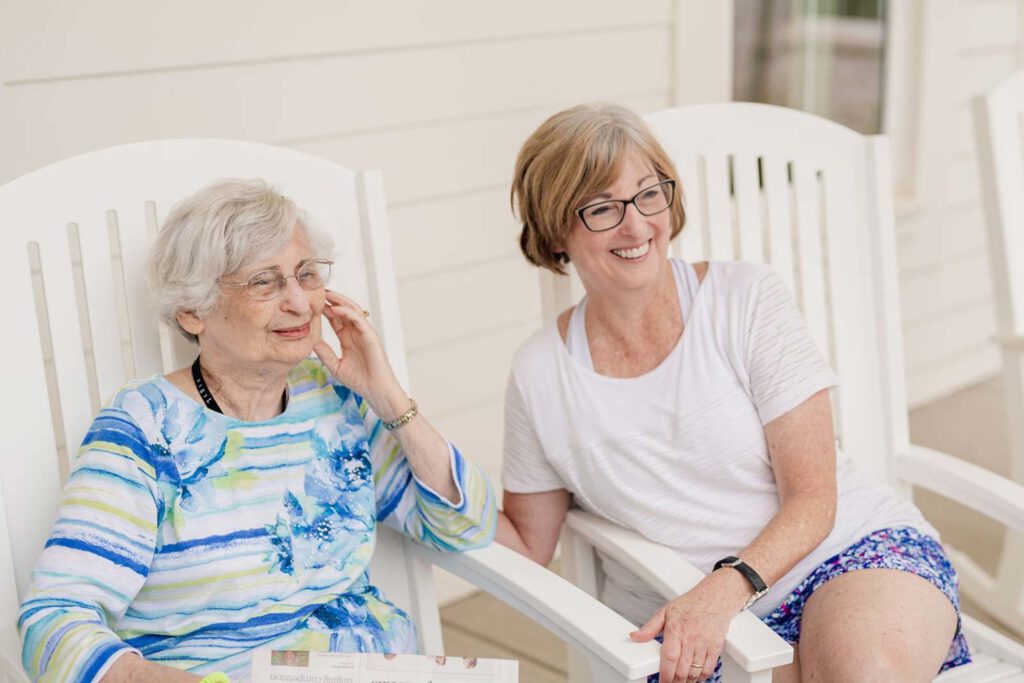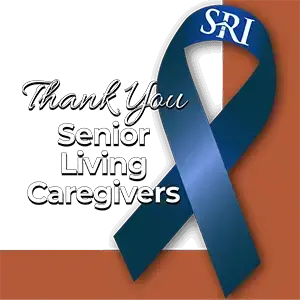-
-
Senior Living is a term encompassing many things, yet it can be defined as a place where seniors have the option to be in an Independent Living, Assisted Living or Memory Care community. Communities frequently have living options from private villas or cottages to apartment-style living offering studio, one or two-bedroom layouts.
-
-
Senior Living communities offer more than medical assistance and care. Senior Living communities focus on a resident’s care, as well as experiences. From art classes to live cooking classes, Senior Living communities – by design – are not the institutional clinics. When a senior chooses to live in a Senior Living community, the community is a neighborhood offering in-house salons, happy hours, pool and spa options, dining rooms, putting greens, game rooms and scheduled housekeeping.
-
-
The first type of care level is Independent Living.
As the name implies, Independent Living is for seniors who can care for themselves without the need of any assistance, and usually offer communal living like that of an apartment complex. There are also a few more amenities included with Independent Living. First, there’s the option to have meals in a dining room and participate in activities within the community. On occasion, you may find Independent Living as a standalone community, or as a part of a larger community that also offers Assisted Living and/or Memory Care.
Depending on the senior living community, there might be standalone villas or cottages. These living options are often like residential homes or townhouses giving a larger square footage choice to those needing more space. Sometimes villas or cottages have attached garages.
This brings us to the second type of care level, Assisted Living.
Assisted Living is appropriate for seniors who can no longer live independently and require assistance day to day. This assistance can include (but is not limited to) help with bathing, dressing, medications, and eating. Residents may only need assistance with one activity or multiple activities. Assisted Living communities allow for seniors to get the assistance they need while still being as independent as possible while enjoying life. Amenities in Assisted Living communities typically include three meals a day, engaging activities, and outings in the local community.
Next up is Memory Care.
Memory Care communities serve residents who have Alzheimer’s Disease and other types of dementia. These communities are equipped to handle the special assistance residents with dementia often require while preserving their quality of life. This often includes those with later stages of Alzheimer’s or dementia, or those who are prone to leaving their home and wandering. Just because a resident is in Memory Care doesn’t mean they lose the zest in their life. Activities departments plan appropriate (and fun) activities, as well as outings.
-
-
Services: Senior living encompasses many things, including independent living, assisted living, and memory care. As you look at communities, the levels of care offered will be vital in making a final decision. Also, does the community include care management, daily activities, housekeeping, laundry, medication management, transportation, or meals?
Atmosphere: Is the atmosphere of the community friendly and welcoming? Listen to feedback from residents and family members can be a good way to learn about another individual’s experiences. A great way to get a sense of the atmosphere is to visit a community’s social media pages.
Care: Talk to the staff at the community, are they well acquainted with all the residents? How is the staff-to-resident ratio? A knowledgeable team will also be able to advise you on the level of care you or a loved one may need if you are new to senior living. Safety and security are also important, remember to ask about their emergency procedures, and any specific care-related questions specific to you or your loved one.
Activities: Check the community activity calendar to see if there are a good variety of activities for residents to participate in every day. Look for well-rounded activities such as: exercise classes, themed parties, outings, card games, and trivia!
Leases & Payments: One of the most important factors is how you will pay for the community. Some communities offer month-to-month leases, while others will require a longer lease. Ask about what is included, and whether there are any added fees.
-
-
Food is one the most important aspects of a Senior Living community. Residents should experience immediate and direct benefits from a positive dining experience.
Lack of eating is often due to a lack of interest, boring menu selections, or a feeling that the food is too much trouble or effort to prepare or eat. Giving seniors more than food as a reason to come to the dining room is important to overcoming bad choices. Creating a dining experience will motivate and encourage eating, as well as socialization with others.
Poor health is often a result of poor nutrition caused by choosing not to eat. Communities who care about their residents, care about what is on their resident’s plates. Ask the communities you are interested in touring to prepare a meal for sampling – you’ll see and taste firsthand what’s being served.
-
-
As we age, it is important to maintain an active lifestyle for many reasons, benefits include increased mobility, lowered risk of stroke and heart disease, elevated mood, enhanced ability to learn, and appreciation of self.
Communities should encompass activities pertaining to mind, body and spirit. Exercise is not just for the body and painting is not just for relaxation. Exercise can work the mind and painting can work the body with hand eye coordination. Singalongs have triggered Memory Care residents to sing when they no longer talk.
Activities will vary from community to community, but here’s a list of common activities:
- Chair yoga or pool yoga (for Independent Living residents)
- Painting classes
- Social hours
- Book clubs in Library
- Walking club
- Cooking classes
Know that a great community activities director will have a month’s worth of events preplanned.
It is easy to become more sedentary when aging, but consistently exercising and stimulation the brain can help boost overall health in the body and mind. Don’t forget to check out a community’s Facebook page to get a since of how active residents are.
-
-
Like activities, amenities vary from community to community. Many communities offer spas, hair and nail salons, full-service private dining rooms, putting greens, transportation to and from appointments, game rooms and scheduled housekeeping that includes linen service.
Some amenities are offered more often depending on a resident’s level of care. For example, Independent Living may have weekly housekeeping with linens washed and dried, but no laundry service. Those in Assisted Living may have weekly housekeeping with linens and laundry service. Memory Care residents may have twice-weekly housekeeping with linens and laundry service, as well as daily bedmaking.
It’s best to contact the community and ask which amenities are included in the overall cost and which ones may require an additional fee.
-
-
Many, if not all, communities provide scheduled transportation to doctors’ visits and can even provide a care staff to go with them if a family member is unavailable. Buses are the most common transportation choice, so residents can sit back and enjoy the ride.
-
-
This is community specific. Some do; some don’t. A pet fee is normally assessed when the resident moves into the community. Often pets are welcome but must be on a leash in common areas. Some communities will even take care of pets for an additional fee.
-
-
From wellness programs, managed care, and emergency response systems, communities today are equipped to provide the most complete care available in senior living. Care level often determines the frequency of regular check-ins.
In Memory Care, there are routine, and scheduled check-ins. Assisted Living residents are more independent, and check-ins are as needed or if requested, communities will create a schedule check-in process. Many communities have a system in place to check on those living at an Independent Living care level. This system checks on them each morning to be ensure they are up.
-
-
Assisted Living residents will receive help, if needed. Memory Care residents will always receive help.
-
-
This is one of the top five questions when people begin exploring Senior Living. Sometimes it seems like getting a straight answer about cost is difficult. Truth be told, the reason is because each resident’s situation is different, and pinning down an exact amount can be difficult, however not impossible.
Prices vary from community to community and can also vary based on the location within the community. For example, a one-bedroom overlooking a parking lot might be less expensive than one overlooking an idyllic park with a pond.
One thing to remember is the level of care, whether Independent Living, Assisted Living or Memory Care, is a factor in cost. The more assistance a person needs, the higher the cost because more attention is required to give the best possible experience.
When it comes to pricing, it can be bewildering but be straightforward with a community’s sales representative. If something is confusing, then ask to have it explained in detail. A great salesperson will not rush explanations or try to breeze through important details. Their job is to help make sure a potential residents’ needs are met and are comfortable with each decision.
Here are some things to keep in mind and to ask about:
- Sometimes Medicaid/Medicare can be used – Note that this is community specific.
- Veterans and/or survivors who qualify may be eligible for funds that are added to the monthly VA pension.
- Don’t assume the cost is out of reach; there might be incentives or programs available to those who qualify.
Contact the sales team at the community and set up a time to discuss all costs and payment options.
-
-
If you find that you’re struggling with daily tasks—like bathing, dressing, cooking, and driving—and you’re worried about your safety, it may be time to consider moving to an assisted living community. Here, you can still live independently, but with the peace of mind that trained staff are available around the clock to provide assistance when you need it most.
-
-
Yes! It is common for senior living communities that offer multiple care levels to be set up in a way that accommodates the changing needs of all our residents, from active adults and independent living to assisted living and memory care. This ensures that you always have access to the best care without having to go through the hassle of moving to another community.
-
-
Yes, memory care is licensed by the state where the community is located and has specific requirements. Therefore, those in memory care must live in that secured part of the community.
-
-
Yes! According to a recent NIC* study, residents in senior living communities experience fewer hospitalizations due to:
- Falls – 18% less
- Hip Fractures – 15% less
- Physical Injuries – 24% less
- Wounds – 36% less
- COPD/Asthma – 15% less
- Dehydration – 21% less
- UTIs – 20% less
*National Investment Center on Seniors Housing & Care






for
special events
and offers